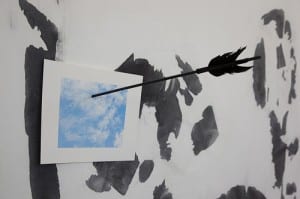UCL Slade BA Fine Art Summer Show
By ucyondr, on 10 June 2011
“I have been at Slade for two years now, and my personal experience of the show was many-layered. On the one hand, I was viewing the work of friends and fellow students with whom I had regularly exchanged opinions and criticism in seminars over several years,” reports UCL Slade school student and artist Tom Rees on the UCL Slade BA Fine Art Summer Show.

Slade exhibit by Kitty Clark
Some of the work I had seen before, having experienced it first during the weekly ‘crits’ that form the backbone of students’ shared development at the Slade. Seeing this work fixed or projected within what is normally studio space, the sensation was of a door having shut between us: I was now more a viewer than a participant. I felt this while watching Tom Clark’s ‘White Paper’, a video piece which evoked something between a child’s first impressions of the world, and a graduating artist conscious of the expectations upon him.
Images of a pair of hands drawing with coloured pastels developed into a sequence where the artist enacted a strange, child-like embrace with one of the Portico’s pillars. Large text overlaid the images, at first matter-of-factly spelling out ‘hands/ face/ jumper’ etc. as they appeared in shot, and then elaborating new, sometimes comic meanings to the images beneath. This was a good strategy to deepen the layers of meaning in a medium that is sometimes criticised for a lack of depth. The text also suggested a deadpan reply to the obligatory enquiry of some -“So what is it?” – when faced with work which is not immediately graspable.
Expecting a spectacle
The world of art students perused and picked up by art dealers such as Charles Saatchi at degree shows of the 1990s is now more of a memory than a reality, but selling your artist-self alongside the work is one aspect of an art market that awaits outside the art-college ‘womb’. Contact cards, prices and CVs – I spotted students quickly passing an eye over each others’ credentials – all make their yearly appearance within the college’s studios before being quietly removed. These trappings go alongside the expectation of some kind of spectacle – a difficult one if your work isn’t loud or monumental.
Degree-showers adopt different strategies to variously and often simultaneously sidestep, parody or accept these norms. Kitty Clark’s ‘Behind us lies the splendour of a lost civilisation’, incorporated a daily confetti drop, and John Shevlin periodically raised and brought down again a large cloth monument as part of his work. Both provided a humorous display for those expecting a grand spectacle.
Individual voices, collaborative voices
The most striking aspect of the show, however, was the extent to which fellow students had sensitively negotiated their works and the space between them to create rooms which credited the individual personalities, while generating new, collaborative voices. This was perhaps clearest in the room showing the work of Cyrus Shroff, Anna Hodgson and Eleanor Wright, from the Painting, Media and Sculpture departments respectively. Art education models nowadays differ between colleges on whether departments are divided up by medium, or whether to do away with such formal distinctions all together. Here was an example of distinct disciplines talking to one another sensitively, echoing the attitude of ex-tutor Phyllida Barlow that the “cusp between disciplines” is “most interesting place to be”.
 Close
Close

